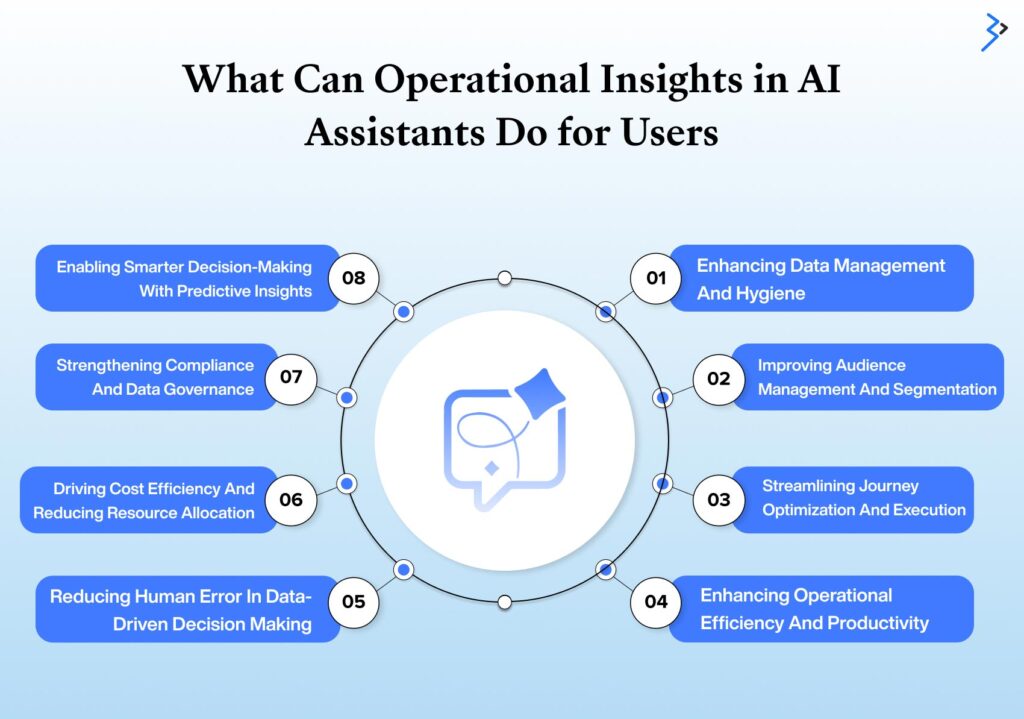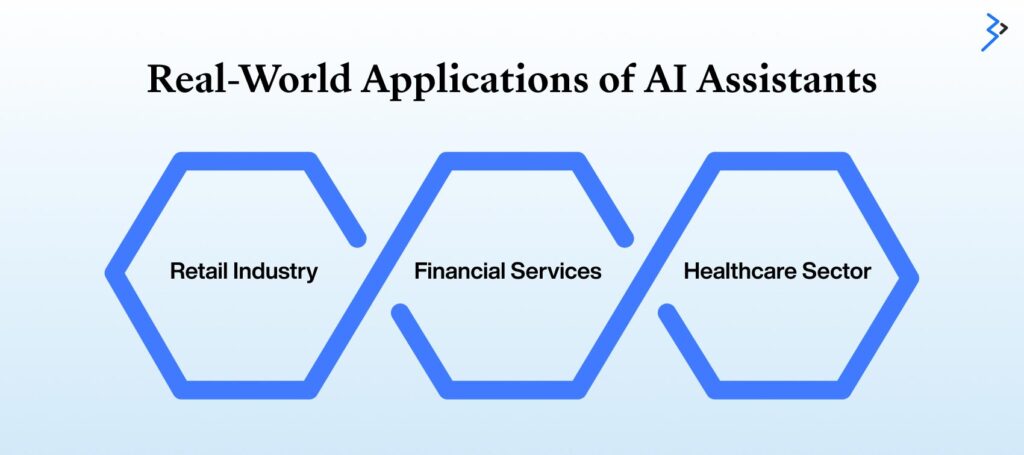Designed as a generative AI tool, the AI Assistant in Adobe Experience Platform will transform how consumers interact with Adobe Experience Cloud apps like Adobe Customer Journey Analytics, Adobe Real-Time Customer Data Platform, and Adobe Journey Optimizer.
AI assistant users should consider two types of questions: operational insights and product knowledge. Product knowledge is ideas and subjects based on Adobe documentation covering general concepts, tutorials, and product use. Without seeing any end customer or account data inside a customer’s sandbox, operational insights are responses that the AI Assistant produces metadata using the customer’s objects — including lineage effect, counts, and lookups.
Users of AI Assistant can ask operational insights inquiries here:
- How many datasets are available?
- How many unused schema attributes are there?
- Which audiences have become active?
- Show me crowds replicated elsewhere.
As of February 18, 2025, all Real-Time CDP and Journey Optimizer users will generally be able to ask for AI Assistant operational insights.
What Can Operational Insights in AI Assistants Do for Users?

For companies using the Adobe Experience Platform (AEP), the operational insights capacity of AI Assistant transforms their game-changing tool. It offers real-time, actionable analytics to let teams all over a company simplify their processes, increase data accuracy, maximize customer interaction techniques, and sharpen decision-making.
Using operational insights from AI assistants, marketing teams, data engineers, and IT experts can help to uncover increased daily process efficiency. The main advantages artificial intelligence assistants deliver to companies by providing operational insights in several spheres of their operations are explored below.
1. Enhancing Data Management and Hygiene
For companies in the digital sphere, efficient data management is vital. Providing a complete picture of how Experience Data Model (XDM) fields are being used, AI Assistant helps teams manage and monitor data flow across schemas and datasets. This capacity helps companies have a neat, orderly dataset that enhances operational effectiveness.
Keeping accurate information and eliminating duplicate or useless properties in their schemas are some of the primary difficulties companies face. Finding unnecessary fields inside a schema or following relationships between datasets might take a long time without operational insights. AI assistant answers questions like these to streamline things:
- “How many datasets have been imported under the same schema?”
- “Which XDM fields go unused in any audience?”
AI Assistant lets data engineers rapidly surface such information so they may simplify their data architecture, avoid needless schema bloat, and guarantee that data stays clean and usable. By using AI Assistant to track data utilization across the platform, users have claimed saving up to one full day every week in manual data validation chores.

2. Improving Audience Management and Segmentation
Modern marketing is fundamentally based on audience management, so artificial intelligence assistants’ operational insights help to better grasp where audiences are utilized and how they are performing.
Managing significant audience inventories, tracking active audiences, and spotting audience definition repetitions may all challenge marketers. By letting people inquire, artificial intelligence assistants simplify audience management:
- “Show me duplicate audiences depending on definition.”
- “Which audiences activate to destination X?”
This capability enables companies to maintain correct audience lists, spot and combine duplicate audiences, and enhance segmentation techniques. Simplifying audience management helps companies to maximize targeting plans and lower marketing campaign inefficiencies.
Using AI Assistants for audience management, companies have reported time savings of around 12 hours every campaign cycle, freeing them to concentrate on improving audience tactics instead of labor-intensively searching for audience-related data.
Read More-: Elevate your Adobe Experience Manager Sites Website with Generative AI Chatbots
3. Streamlining Journey Optimization and Execution
Customer journey management and marketing automation depend on constant monitoring for the best engagement and effectiveness. Operational insights from artificial intelligence assistants give trip managers helpful information on travel cleanliness, audience activation state, and active journey count. Users may question:
- “Which groups are triggered to go X?”
- “Do I have any travels with the word ‘test’ in the name?”
These revelations enable teams to rapidly identify and maximize user journeys, ensuring that test paths are not inadvertently left active and that resources are used wisely. Several companies have reported saving over one full day per week by tracking trip performance and activation using AI Assistant, lowering manual checks, and improving process automation.
4. Enhancing Operational Efficiency and Productivity
Beyond data and audience management, operational insights in artificial intelligence assistants let marketing operations, IT teams, and customer experience teams increase their general efficiency. AI assistants’ quick responses to operational inquiries help lower the need for manual data searches, API calls, or dashboard querying several times.
IT staff, for example, frequently have to monitor data lineage, analyze system dependencies, and evaluate platform health. AI Assistant can offer information right away, including:
- “Which data sets have changed during the past thirty days?”
- “What are the top five most used properties in my schema?”
With this real-time knowledge, companies may proactively spot possible congestion, improve system performance, and guarantee data integrity. Organizations, therefore, see faster reaction times and higher productivity as teams can make wise judgments quickly instead of wasting hours compiling information from several sources.
5. Reducing Human Error in Data-Driven Decision Making
Human error is among the main hazards in every data-driven company. These errors might result in costly blunders in manual data searches, audience segment misreading, and mishandling of journey activations. By providing exact, automated insights based on operational data, AI Assistant helps reduce these risks and guarantees that companies rely on correct information when making choices.
AI Assistant helps companies eliminate mistakes related to misconfigured datasets, duplicate audience activations, and erroneous customer journey activations by lowering the dependence on manual procedures. Better marketing effectiveness and a more significant return on investment (ROI) follow from organizations with more trust in their data quality.
6. Driving Cost Efficiency and Reducing Resource Allocation
AI Assistant lets companies maximize personnel and lower data management expenses by automating regular operational searches. Businesses may focus their skills on high-value strategic projects such as improving customer experience and sophisticated analytics instead of committing expensive IT and marketing resources to repetitious administrative activities.
For instance, companies that used AI Assistants immediately noticed an increase in operational efficiency compared to companies that had earlier committed several hours per week to hand-based audits. These time savings translate into financial savings that let businesses reallocate funds toward strategic marketing projects and innovation.
7. Strengthening Compliance and Data Governance
Businesses handling client data in the current regulatory scene depend on compliance and data governance. AI Assistant guarantees that data stays under specified legal limits by giving rapid access to metadata insights and supporting compliance efforts.
Companies may ask an AI Assistant, for example, to validate:
- “Which datasets include personally identifiable information (PII)?” asks one.
- “Which fields in my schema are under active campaign use?”
These revelations help companies meet legal obligations, reduce data security threats, and guarantee transparency regarding consumer data usage. Companies using AI assistants for data governance have seen a notable increase in their capacity to monitor and control data permissions, guaranteeing industry standards, including GDPR and CCPA compliance.
8. Enabling Smarter Decision-Making with Predictive Insights
AI assistants can answer operational questions and enable companies with predictive insights to help foresee problems and maximize performance. By examining past data trends, an AI Assistant may offer suggestions on which audiences are most successful, which paths create the best interaction, and where data bottlenecks occur.
An AI Assistant could, for example, suggest:
- “Your most involved audience segment is [X]. Give this audience top priority for your future campaign.
- “Your rates of completion of your journeys have reduced by 15% over the last month. Review possible obstacles.
These proactive insights improve strategic decision-making and let teams adjust their marketing initiatives depending on data-driven advice.
Read More-: Agentic Chatbots: Empowering AI with Tools and Reasoning
Real-World Applications of AI Assistants

Businesses using AI Assistants in AEP have shown a noticeable increase in operational effectiveness. Here are actual uses showing how artificial intelligence assistants may revolutionize corporate processes:
1. Retail Industry: Personalized Customer Experiences
A leading retail company used an artificial intelligence assistant in its AEP process to examine audience segmentation and activation. The company improved its customer engagement strategy by asking the AI Assistant for audience duplication and activation patterns, resulting in a 20% improvement in conversion rates and a 15% decrease in marketing expenditures.
2. Financial Services: Data Compliance and Accuracy
A global financial institution utilized an AI Assistant to maintain data hygiene throughout several client touchpoints. Tracking empty XDM fields and enhancing dataset management helped the organization guarantee regulatory compliance and reduce data inconsistencies by 25%, raising customer satisfaction.
3. Healthcare Sector: Journey Optimization for Patient Engagement
Using an AI Assistant to monitor patient engagement paths, a healthcare practitioner guaranteed a flawless contact channel. The provider raised patient appointment adherence by thirty percent through improved segmentation and identification of underperforming paths.
Read More-: Maximize Creativity with Adobe Gen: The Ultimate Guide
What’s Next for AI Assistants?
Adobe is dedicated to increasing the powers of AI assistants outside of operational knowledge. The next stage of evolution will bring features including:
- AI Assistant will offer predicted insights and graphical trend representations, supporting data-driven decision-making.
- AI Assistant will use AI-driven advice to hone audience segmentation, enhancing targeting accuracy.
- AI assistants will improve support processes by spotting shared client issues and providing resolution techniques.
Conclusion
Using the Adobe Experience Manager Services, artificial intelligence assistants are transforming corporate data and operational processes. Through real-time operational insights, AI Assistant helps companies simplify data administration, maximize audience segmentation, and improve journey execution. With its forthcoming improvements, the AI Assistant will keep releasing fresh degrees of intelligence and efficiency, making it a necessary tool for data-driven companies.
Companies using artificial intelligence assistants will have a competitive edge in using real-time data insights as they develop. AI-powered operational intelligence is here, and companies embracing these technologies will flourish in a society that is becoming increasingly data-centric.
Related Articles
-
Integrate AEM with Salesforce: Your DIY Guide
Summary An organization is as successful as its software suite. Wonder why? Access to the best software allows organizations to streamline different aspects of their business and automate their workflow.
-
Empowering Your Business with Analytics: Making Informed Choices Using Adobe Commerce Data
Both technology and shopping trends are always in a state of constant evolution. Any company that doesn’t adapt to these changes is bound to see failure in the long run.
-
A Guide to Implementing AEM for Your Business
Adobe Experience Manager (AEM) is one of the most innovative content management platforms. It integrates digital asset management, site management, and content delivery to help organizations create a seamless customer




